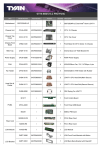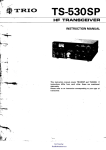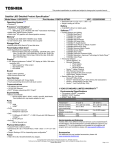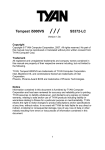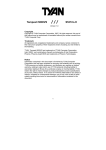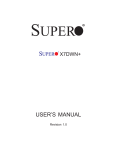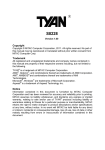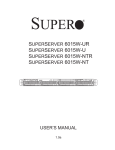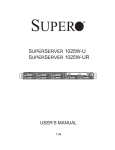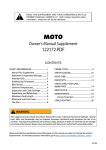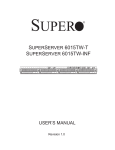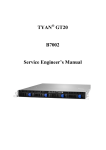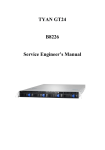Download Tank GT14 B5372-LC Service Engineer`s Manual
Transcript
Tank GT14 B5372-LC Service Engineer’s Manual PREFACE Copyright This publication, including all photographs, illustrations, and software, is protected under international copyright laws, with all rights reserved. Neither this manual, nor any material contained herein, may be reproduced without written consent of the manufacturer-. Copyright 2007 Version 1.0 Disclaimer Information contained in this document is furnished by TYAN Computer Corporation and has been reviewed for accuracy and reliability prior to printing. TYAN assumes no liability whatsoever, and disclaims any express or implied warranty, relating to sale and/or use of TYAN products including liability or warranties relating to fitness for a particular purpose or merchantability. TYAN retains the right to make changes to product descriptions and/or specifications at any time, without notice. In no event will TYAN be held liable for any direct or indirect, incidental or consequential damage, loss of use, loss of data or other malady resulting from errors or inaccuracies of information contained in this document. Trademark Recognition All registered and unregistered trademarks and company names contained in this manual are property of their respective owners including, but not limited to the following. TYAN and Tank GT14 B5372-LC are trademarks of TYAN Computer Corporation. Intel, Xeon, Blackford-VS, and combinations thereof are trademarks of Intel Corporation. Phoenix, Phoenix-Award BIOS, and combinations thereof are trademarks of Phoenix Technologies. Microsoft and Windows are trademarks of Microsoft Corporation. XGI and XG20 are trademarks of XGI Corporation nVIDIA and nForce are trademarks of NVIDIA Corporation. Winbond is a trademark of Winbond Electronics Corporation. Portable Document Format (PDF) is a trademark of Adobe Corporation. i Federal Communications Commission (FCC) Notice for the USA Compliance Information Statement (Declaration of Conformity Procedure) DoC FCC Part 15: This device complies with part 15 of the FCC Rules Operation is subject to the following conditions: 1) This device may not cause harmful interference, and 2) This device must accept any interference received including interference that may cause undesired operation. If this equipment does cause harmful interference to radio or television reception, which can be determined by turning the equipment off and on, the user is encouraged to try one or more of the following measures: – Reorient or relocate the receiving antenna. – Increase the separation between the equipment and the receiver. – Plug the equipment into an outlet on a circuit different from that of the receiver. Consult the dealer on an experienced radio/television technician for help. Notice for Canada This apparatus complies with the Class B limits for radio interference as specified in the Canadian Department of Communications Radio Interference Regulations. (Cet appareil est conforme aux norms de Classe B d’interference radio tel que specifie par le Ministere Canadien des Communications dans les reglements d’ineteference radio.) Notice for Europe (CE Mark) This product is in conformity with the Council Directive 89/336/EEC, 92/31/EEC (EMC). CAUTION: Lithium battery included with this board. Do not puncture, mutilate, or dispose of battery in fire. Danger of explosion if battery is incorrectly replaced. Replace only with the same or equivalent type recommended by manufacturer. Dispose of used battery according to manufacturer instructions and in accordance with your local regulations. ii About this Manual This manual provides you with instructions on installing your Tank GT14. This manual is intended for experienced users and integrators with hardware knowledge of personal computers. This manual consists of the following parts Chapter 1: Provides an Introduction to the Tank GT14 B5372LC barebones, packing list, describes the external components, and provides block diagrams of the system. Chapter 2: Covers procedures on installing the CPU, memory modules, a PCI Express card, and hard drives. Chapter 3: Covers removal and replacement procedures for pre-installed components Appendix: Describes the differences between mainboard BIOS and system BIOS. Provides the FRU parts list and cable connection tables for reference of system setup. Instructions on installing the SMDC card and reversing the GT14 chassis are also provided. For information on the mainboard, please refer to the attached mainboard user’s manual. You can find the detailed description about jumper and BIOS settings from the motherboard manual. iii SAFETY INFORMATION Before installing and using the Tank GT14, take note of the following precautions: iv – – – Read all instructions carefully. – Only use the power source indicated on the marking label. If you are not sure, contact the Power Company. – The unit uses a three-wire ground cable, which is equipped with a third pin to ground the unit and prevent electric shock. Do not defeat the purpose of this pin. If your outlet does not support this kind of plug, contact your electrician to replace your obsolete outlet. – Do not place anything on the power cord. Place the power cord where it will not be in the way of foot traffic. – Follow all warnings and cautions in this manual and on the unit case. – Do not push objects in the ventilation slots as they may touch high voltage components and result in shock and damage to the components. – When replacing parts, ensure that you use parts specified by the manufacturer. – When service or repairs have been done, perform routine safety checks to verify that the system is operating correctly. – Avoid using the system near water, in direct sunlight, or near a heating device. – Cover the unit when not in use. Do not place the unit on an unstable surface, cart, or stand. Do not block the slots and opening on the unit, which are provided for ventilation. Table of Contents Chapter 1:Overview 1.1 1.2 1.3 1.4 1.5 About the Tank GT14 B5372-LC . . . . . . . . . . . . . . . . . . . . . . . . . . 1 Product Model. . . . . . . . . . . . . . . . . . . . . . . . . . . . . . . . . . . . . . . . . 1 Features . . . . . . . . . . . . . . . . . . . . . . . . . . . . . . . . . . . . . . . . . . . . . . 2 Unpacking . . . . . . . . . . . . . . . . . . . . . . . . . . . . . . . . . . . . . . . . . . . . 4 About the Product . . . . . . . . . . . . . . . . . . . . . . . . . . . . . . . . . . . . . . 7 1.5.1 Front View . . . . . . . . . . . . . . . . . . . . . . . . . . . . . . . . . . . . . . 7 1.5.2 Rear View . . . . . . . . . . . . . . . . . . . . . . . . . . . . . . . . . . . . . . 7 1.5.3 LED Definition . . . . . . . . . . . . . . . . . . . . . . . . . . . . . . . . . . 8 1.5.4 Internal View . . . . . . . . . . . . . . . . . . . . . . . . . . . . . . . . . . . . 9 1.5.5 Motherboard Block Diagram . . . . . . . . . . . . . . . . . . . . . . . 10 1.5.6 Motherboard Layout . . . . . . . . . . . . . . . . . . . . . . . . . . . . . 11 Chapter 2:Setting Up 2.1 2.2 2.3 2.4 2.5 2.0.1 Before You Begin . . . . . . . . . . . . . . . . . . . . . . . . . . . . . . . 13 2.0.2 Work Area . . . . . . . . . . . . . . . . . . . . . . . . . . . . . . . . . . . . . 13 2.0.3 Tools . . . . . . . . . . . . . . . . . . . . . . . . . . . . . . . . . . . . . . . . . 13 2.0.4 Precautions. . . . . . . . . . . . . . . . . . . . . . . . . . . . . . . . . . . . . 14 Installing Motherboard Components. . . . . . . . . . . . . . . . . . . . . . . 15 2.1.1 Removing the Top Chassis Cover . . . . . . . . . . . . . . . . . . . 15 2.1.2 Installing the CPU and Heatsink . . . . . . . . . . . . . . . . . . . . 16 2.1.3 Installing the Memory . . . . . . . . . . . . . . . . . . . . . . . . . . . . 19 2.1.4 Installing the PCI-E Card. . . . . . . . . . . . . . . . . . . . . . . . . . 21 Installing Dual 2.5” Hard Drives . . . . . . . . . . . . . . . . . . . . . . . . . 23 Rack Mounting . . . . . . . . . . . . . . . . . . . . . . . . . . . . . . . . . . . . . . . 26 2.3.1 Installing the Server in a Rack (with Rail kit A) . . . . . . . . 27 2.3.2 Installing the Server in an Open Rack (with Rail kit B) . . 32 LCD Software Setup . . . . . . . . . . . . . . . . . . . . . . . . . . . . . . . . . . . 35 2.4.1 Configuring the System . . . . . . . . . . . . . . . . . . . . . . . . . . . 35 2.4.2 M1000 Driver Installation for Windows . . . . . . . . . . . . . . 35 2.4.3 M1000 Driver Installation for Linux . . . . . . . . . . . . . . . . . 35 LCD Console. . . . . . . . . . . . . . . . . . . . . . . . . . . . . . . . . . . . . . . . . 36 2.5.1 Key Definition . . . . . . . . . . . . . . . . . . . . . . . . . . . . . . . . . . 36 2.5.2 DOS Mode and Windows Mode . . . . . . . . . . . . . . . . . . . . 37 2.5.3 Linux Mode . . . . . . . . . . . . . . . . . . . . . . . . . . . . . . . . . . . . 40 Chapter 3:Replacing Pre-Installed Components 3.1 Introduction . . . . . . . . . . . . . . . . . . . . . . . . . . . . . . . . . . . . . . . . . . 43 3.1.1 Work Area . . . . . . . . . . . . . . . . . . . . . . . . . . . . . . . . . . . . . 43 3.1.2 Tools . . . . . . . . . . . . . . . . . . . . . . . . . . . . . . . . . . . . . . . . . 43 v 3.2 3.3 3.4 3.5 3.6 3.7 3.8 3.1.3 Precautions. . . . . . . . . . . . . . . . . . . . . . . . . . . . . . . . . . . . . 44 Disassembly Flowchart . . . . . . . . . . . . . . . . . . . . . . . . . . . . . . . . . 45 Removing the Top Chassis Cover. . . . . . . . . . . . . . . . . . . . . . . . . 46 Replacing Motherboard Components . . . . . . . . . . . . . . . . . . . . . . 47 3.4.1 Disconnecting All Motherboard Cables . . . . . . . . . . . . . . 47 3.4.2 Removing the Motherboard . . . . . . . . . . . . . . . . . . . . . . . . 48 Replacing the LCD Module and LED Board . . . . . . . . . . . . . . . . 49 3.5.1 M1000 LCD Module Features. . . . . . . . . . . . . . . . . . . . . . 52 3.5.2 M1017 LED Board Features . . . . . . . . . . . . . . . . . . . . . . . 52 3.5.3 M1017 LED Board Connector Pin Definition. . . . . . . . . . 53 Replacing the USB Board . . . . . . . . . . . . . . . . . . . . . . . . . . . . . . . 54 3.6.1 USB Board Features . . . . . . . . . . . . . . . . . . . . . . . . . . . . . 55 3.6.2 USB Board Connector Pin Definition . . . . . . . . . . . . . . . . 55 Replacing the Cooling Fans . . . . . . . . . . . . . . . . . . . . . . . . . . . . . 56 Replacing the Power Supply . . . . . . . . . . . . . . . . . . . . . . . . . . . . . 57 Appendix I: BIOS Differences Appendix II: Cable Connection Tables Appendix III: Installing the SMDC Card Appendix IV: FRU Parts Table Technical Support vi Chapter 1: Overview 1.1 About the Tank GT14 B5372-LC Congratulations on your purchase of the TYAN TankTM GT14 B5372-LC, a highly-optimized rack-mountable barebone system. The Tank GT14 B5372-LC is designed to support up to 2 Intel® Xeon 5000/5100LV/5300(80W)/5300LV series processors, providing a rich feature set and incredible performance. Leveraging advanced technology from Intel®, the Tank GT14 B5372-LC server system is capable of offering scalable 32 and 64-bit computing, high-bandwidth memory design, and a lightning-fast PCI-Express bus implementation. The TankTM GT14 B5372-LC not only empowers your company in today’s demanding IT environment but also offers a smooth path for future application usage. TYAN is also proud to deliver the TankTM GT14 B5372-LC in SATA flavor while supporting two (2) internal hard drives. The TankTM GT14 B5372-LC uses TYAN’s latest tooling-made chassis featuring a robust structure, tool-less and modularized design, and a solid mechanical enclosure. All of these provide the TankTM GT14 B5372-LC the power and flexibility to meet the needs of nearly any server application. 1.2 Product Model Model HDD Bays Hot-Swap Support GT14 B5372-LC Internal, 2 HDDs No Chapter 1: Overview 1 1.3 Features Enclosure • Industry 19” rack-mountable 1U chassis – (2) 2.5” HDD internal tray • Dimensions: – D 14.4 x W 17.2 x H 1.71 inch (D 365 x W 436 x H 43.5mm) Processors • Dual LGA771 sockets • Supports up to 2 Intel® Xeon 5100/5100LV/5300(80W)/5300LV series processors • 1066/1333MHz FSB • LED indicators – Power LED – (2) LAN LEDs – ID LED – HDD active LED – Warning LED • Switches – Power switch – ID switch Integrated Storage Controller Chipsets • ESB2 – Single channel master mode supports two (2) IDE devices – Supports up to four (4) ports running up to 3.0Gb/s • Intel® 5000V (Blackford-VS) MCH Storage ® • Intel ESB2 I/O Controller Hub • SMSC SCH5017 Super I/O Chip • SMSC EMC6D103 H/W monitoring IC Memory • Dual memory channels • Supports six (6) Fully-Buffered DIMMs • DDR2 667/533 memory Expansion Slots • Aligned (1) 64-bit/133MHz PCI-X slot and (1) x8 PCI-E slot, supporting PCI-E (x16 slot, M20822) • Optional 133MHz PCI-X (M2055) riser card • Supports (1) full height/full length add-in card Back I/O Ports • Stacked PS/2 mouse & keyboard ports • Stacked two (2) USB 2.0 ports • One (1) 15-pin VGA port • One (1) 9-pin COM port • Two (2) RJ-45 10/100/1000 Base-T ports • Hard Disk Drives: – Supports two (2) SATA/SATA2 HDD with RAID 1, 0 Networking • Two LAN ports – Dual Gigabit ports (ESB2 embedded) with i82563EB dualPHY Video • XGI® XG20 PCI graphics controller • 16MB DDR Frame Buffer of video memory Motherboard • TYAN S5372 G2NR-LC system board • SSI CEB v1.01 footprint (12 x 10.5 inch) BIOS • Phoenix BIOS® on 8Mbit Flash ROM • Supports APM 1.2, ACPI 1.0 • Serial Console Redirect • USB boot supported • PnP, DMI2.0, WfM2.0 power management Front Panel Features • I/O: (2) USB 2.0 ports 2 Chapter 1: Overview Server Management • System fan speed monitoring and control • Supports Tyan Server Management (TSM) • Optional TYAN M3291 SMDC kit, IPMI 2.0 compliant • Supports TYAN LCM module System Cooling • (4) 40x40x28mm 15000rpm heavyduty fans with fan speed monitor/control • (2) Passive CPU heatsinks Power Supply • High efficiency (80+) EPS 12V, 1U, 400W with PFC • 100V~240V AC input Regulatory • FCC Class A (Declaration of Conformity) • CE (Declaration of Conformity) • VCCI • C-Tick Environment Temperature • Operating temperature 5oC~35oC • Non-operating temperature -40oC ~ 70oC Chapter 1: Overview 3 1.4 Unpacking If any items are missing or appear damaged, contact your retailer or browse to TYAN’s Web site for service: http://www.tyan.com. The Web site also provides information on other TYAN products, plus FAQs, compatibility lists, BIOS settings, and more. 1 x Tyan driver CD Power Cables Left to right: Europe, US HDD Screws Barebone & Mainboard Manual LCD Bracket x 1 Heatsink x 2 Mounting Ear Kit 4 Chapter 1: Overview Rail Kit Rail kit options: A, B, C The following three rail kits are available to rackmount your GT14 B5372-LC. A. Rail for 4-post rack Sliding Rails x2 Sliding Brackets x4 (Front L-Bracket x2, Rear L-Bracket x2) Mounting Brackets x 4 M4-4L screw x 18pcs M5-8L screw x 10pcs M5-15L screw x 4pcs B. Rail for 2-post rack Inner Rail Brackets x2 (including screws) Mounting Brackets x2 M5-8L screw x 14pcs M4-4L screw x 8pcs Chapter 1: Overview 5 C. Rail for 4-post rack Inner Rails x2 Post Slide Mounting Brackets x4 Assembled Outer Sliding Rails x2 M4-4L screw x 30pcs M5-8L screw x 10pcs M5-15L screw x 4pcs NOTE: For detailed information on rail kit of C, please contact our sales representative. 6 Chapter 1: Overview 1.5 About the Product The following views show you the product. 1.5.1 Front View HDD Access LED LAN2 LED LAN1 LED ID LED Power LED Warning LED Power button LCD buttons ID button 2 x USB ports LCD Display 1.5.2 Rear View Power Supply Socket PS/2 Mouse/Keyboard Ports 2 USB Ports Serial Port PCI-E Card Opening 2 GbE LAN Ports (10/100/1000) VGA Port Chapter 1: Overview 7 1.5.3 LED Definition Front Panel LED Color State Description Power Green OFF ON OFF Power ON Power OFF HDD Access Amber OFF Random Blink OFF HDD access No disk activity LAN1/LAN2 Activity Green Green OFF ON Blinking OFF LAN linked LAN accessing No LAN linked Warning Red ON OFF OFF System fails (fan fail/ over voltage) Normal Blue OFF ON OFF System is identified System is not identified ID LED Rear I/O LED 8 LED Color State Description LAN Linkage/ Activity (Left Side) Green Green OFF ON Blinking OFF LAN linked LAN accessing No LAN linked LAN Mode (Right Side) Orange Green OFF ON ON OFF 1000Mb mode 100Mb mode 10Mb mode or No LAN linked Chapter 1: Overview 1.5.4 Internal View 1 2 3 4 5 8 FAN4 FAN3 FAN2 FAN1 6 7 1. M2082-2 PCI-E (or M2055 PCI-X) Riser card 2. Memory slots 3. EPS Power supply 4. Power connector Chapter 1: Overview 5. CPU sockets 6. Fans (Right to Left: Fan1, Fan2, Fan3, Fan4) 7. Front LED panel 8. 2.5” Dual hard disk drive 9 1.5.5 Motherboard Block Diagram 10 Chapter 1: Overview 1.5.6 Motherboard Layout Chapter 1: Overview 11 Jumpers & Connectors Jumper /Connector 12 Function JP2/JP3 ASF1.0/SMDC Select Header JP4 Clear CMOS Jumper CN1/CN2 ATX Power Connectors CN4/CN8 CPU Fan Connectors (CN4: CPU0 Fan / CN8: CPU1 Fan) CN9/CN10/ CN13/CN14 Chassis Fan Connectors (CN9: FAN2 / CN10: FAN1 / CN13: FAN3 / CN14: FAN4) CN11 Tyan SO-DIMM Connector CN12 Front Panel USB2.0 Connector CN15 COM2 Header CN19 Front Panel Header CN20 SMDC Connector CN21 LCM Header CN17/CN22 Reserved Chapter 1: Overview Chapter 2: Setting Up 2.0.1 Before You Begin This chapter explains how to install the CPU, CPU heatsink, memory modules, and hard drives. Instructions on inserting a PCI-X card are also given. Take note of the precautions mentioned in this section when installing your system. 2.0.2 Work Area Make sure you have a stable, clean working environment. Dust and dirt can get into components and cause malfunctions. Use containers to keep small components separated. Putting all small components in separate containers prevents them from becoming lost. Adequate lighting and proper tools can prevent you from accidentally damaging the internal components. 2.0.3 Tools The following procedures require only a few tools, including the following: • • A cross head (Phillips) screwdriver A grounding strap or an anti-static pad Most of the electrical and mechanical connections can be disconnected using your fingers. It is recommended that you do not use needle-nosed pliers to remove connectors as these can damage the soft metal or plastic parts of the connectors. Chapter 2: Setting Up 13 2.0.4 Precautions Components and electronic circuit boards can be damaged by discharges of static electricity. Working on a system that is connected to a power supply can be extremely dangerous. Follow the guidelines below to avoid damage to the Tank GT14 or injury to yourself. • Ground yourself properly before removing the top cover of the system. Unplug the power from the power supply and then touch a safely grounded object to release static charge (i.e. power supply case). If available, wear a grounded wrist strap. Alternatively, discharge any static electricity by touching the bare metal chassis of the unit case, or the bare metal body of any other grounded appliance. • Avoid touching motherboard components, IC chips, connectors, memory modules, and leads. • The motherboard is pre-installed in the system. When removing the motherboard, always place it on a grounded anti-static surface until you are ready to reinstall it. • Hold electronic circuit boards by the edges only. Do not touch the components on the board unless it is necessary to do so. Do not flex or stress circuit boards. • Leave all components inside the static-proof packaging that they ship with until they are ready for installation. • After replacing optional devices, make sure all screws, springs, or other small parts are in place and are not left loose inside the case. Metallic parts or metal flakes can cause electrical shorts. Notes: • • 14 All connectors are keyed to only attach one way. Always use the correct screw size as indicated in the procedures. Chapter 2: Setting Up 2.1 Installing Motherboard Components This section describes how to install components on to the motherboard, including CPU, memory modules and a PCI-E card. 2.1.1 Removing the Top Chassis Cover Follow these instructions to remove the Tank GT14 top chassis cover. 1. Remove the screw on the back side and two on the top of the top chassis cover. 2. Slide the top chassis cover in the direction of arrow. 3. Lift the cover off. Chapter 2: Setting Up 15 2.1.2 Installing the CPU and Heatsink Follow these instructions to install the CPU and CPU heatsink. 1. Locate the CPU sockets. Start installing the CPU with CPU0 socket first. CPU0 CPU1 2. Take off the CPU protection cap. 3. Pull the CPU lever up to unlock the CPU socket. 16 Chapter 2: Setting Up 4. Open the socket in the direction as shown. 5. Place the CPU in the CPU socket, ensuring that pin 1 is located as shown below. 6. Close the CPU socket cover and press the CPU socket lever down to secure the CPU. Chapter 2: Setting Up 17 7. Place the heatsink on the top of the CPU and screw into place as shown. 8. Repeat these steps to install CPU and heatsink for the second CPU socket. 18 Chapter 2: Setting Up 2.1.3 Installing the Memory Follow these instructions to install the memory modules on the motherboard. 1. Locate the memory slots on the motherboard. 2. Press the memory slot locking levers in the direction of the arrows as shown in the following illustration. Chapter 2: Setting Up 19 3. Align the memory module with the slot. The module has indentations that align with notches in the slots. 4. Insert the memory module into the slot as shown. See the memory population rules in the following table. When inserted properly, the memory slot locking levers lock automatically onto the indentations at the ends of the module. For optimal system operation, please install memory in pairs. Memory Population Rules DIMM / Channel DIMM6 / DIMMA0 Single Channel X Dual Channel X DIMM5 / DIMMA1 X X X X DIMM4 / DIMMA2 DIMM3 / DIMMB0 DIMM2 / DIMMB1 DIMM1 / DIMMB2 X X X X X X X (X indicates a populated DIMM slot.) NOTE: For optimal dual channel operations, always install memory in pairs beginning with DIMM6 and DIMM3. One pair of DIMM must be of the same type of DIMM. For single channel mode: only one DIMM at DIMM6. Others must be in dual channel mode. 20 Chapter 2: Setting Up 2.1.4 Installing the PCI-E Card Follow these instructions to install a PCI-E card. 1. Remove the screw securing the tab of PCI-X slot from the rear side of your GT14 B5372-LC-LC system. 2. Pull the tab of PCI-X slot on the rear side in the direction as shown to release the I/O shield. 3. Move the I/O shield to left as shown and then take off the I/O shield. Chapter 2: Setting Up 21 4. Insert the PCI-E card in the direction of arrows as shown. 5. Push the tab of PCI-X slot on the rear side in the direction as shown to secure the PCI-X card. 6. Secure the tab of PCI-X slot on the rear side with one screw as shown. 22 Chapter 2: Setting Up 2.2 Installing Dual 2.5” Hard Drives The GT14 chassis kit supports up to two internal SATA hard drives. Follow these instructions to install dual 2.5” internal hard drives. 1. Remove the screw securing the 2.5” drive bracket in the GT14 chassis. 2. Slide the drive tray out (A) and lift the bracket out from the chassis (B). Chapter 2: Setting Up 23 3. Place the two 2.5” hard drives into the 2.5” drive bracket. Use 8 HDD screws to secure the hard drives. 4. Place the assembled hard drives with bracket in the spot you picked the 2.5” hard drive bracket from the GT14 chassis (A) and slide it into place (B). Make sure the assembled hard drives are placed correctly as the indication shown on the chassis. 5. Secure the assembled hard drives with the screw removed in step 1. 24 Chapter 2: Setting Up 6. Connect the two SATA power connectors to the hard drives. Then connect the hard drives to the motherboard using two supplied SATA cables. Chapter 2: Setting Up 25 2.3 Rack Mounting After installing the necessary components, the Tank GT14 can be mounted in a rack using the supplied rack mounting kit. The screw types are listed below for your reference. Screws List Rail for 4-post rack (Rail kit A) Item Screw Size Quantity A M4-4L 18 B M5-8L 10 C M5-15L 4 Rail for 2-post rack (Rail kit B) Item Screw Size Quantity D M5-8L 14 E M4-4L 8 Mounting ear kit screws Item F Screw Size Quantity M4-15L 2 For the complete contents in the rack mounting kit, see “1.4 Unpacking” on page 4 for more information. 26 Chapter 2: Setting Up 2.3.1 Installing the Server in a Rack (with Rail kit A) Follow these instructions to mount the GT14 into an industry standard 19" rack. (Rail kit A) NOTE: Before mounting the Tank GT14 in a rack, ensure that all internal components have been installed and that the unit has been fully tested. Maintenance can be performed on the unit while in a rack but it is preferable to install the device in a fully operational condition. Installing the Inner Rails to Chassis 1. Screw the mounting ear to each side of GT14 as shown using 2 screws from the supplied mounting ear kit. 2. Press the latch and draw out the inner rails from rail assembly. Chapter 2: Setting Up 27 3. Install inner rails to left and right sides of chassis using 1 M4-4L(A) screw for each side. 28 Chapter 2: Setting Up Installing Outer Rails to the Rack 4. Measure the distance between inner side of the front and rear mounting brackets in the rack. 5. Reserve the distance same as in step 4 on rear racket. Secure the rear bracket to outer rail with 2 M4-4L(A) screws. 6. Secure the outer rails to the rack using 2 brackets and 5 M5-8L(B) screws for each side (2 at front side and 3 at rear side). Secure the mounting brackets from inside, not outside, of the rack. Chapter 2: Setting Up 29 Rackmounting the Server 7. Draw out the middle rails to the latch position. 8. Lift the chassis and then insert the inner slide rails into the middle rails. 9. Push the chassis in and press the latch key (A). Then push the whole system into the rack (B). A 30 B Chapter 2: Setting Up 10. Secure the mounting ears of chassis to the rack with one M4-15L(F) screw for each side. NOTE: To avoid injury, it is strongly recommended that two people lift the GT14 into the place while a third person screws it to the rack. Chapter 2: Setting Up 31 2.3.2 Installing the Server in an Open Rack (with Rail kit B) In addition to rackmounting the GT14 in a 4-post rack, you can also mount it in a 2-post rack. You must use rail kit B to mount the GT14 in this type of rack. 2-post open rack NOTE: Before mounting the Tank GT14 in a rack, ensure that all internal components have been installed and that the unit has been fully tested. Maintenance can be performed on the unit while in a rack but it is preferable to install the device in a fully operational condition. 1. Install the inner rail brackets to left and right sides of chassis using 3 M4-4L(E) screws for each side. 32 Chapter 2: Setting Up 2. Lift the chassis and secure the mounting brackets to the front of rack using 3 M5-8L(D) screws for each side. NOTE: To avoid injury, it is strongly recommended that two people lift the GT14 into the place while a third person screws it to the rack. 3. Locate the three small brackets at the rear of rack as shown. Adjust their positions to fit the mounting brackets to be secured in the following steps. Chapter 2: Setting Up 33 4. Slide the mounting brackets into the rear of inner rail brackets as shown. 5. Secure the mounting brackets with three M4-4L(E) screws for each side. 6. The GT14 has been mounted to the rack as shown. 34 Chapter 2: Setting Up 2.4 LCD Software Setup 2.4.1 Configuring the System After you have made the network and power connections, you can configure the network settings using the LCD console. Before You Begin Before you begin, make sure that you have the following information ready: • • IP address assigned to the system Subnet mask of your network’ 2.4.2 M1000 Driver Installation for Windows Step 1. Install TYAN TSM program. Step 2. Install M1000 driver for Windows. 2.4.3 M1000 Driver Installation for Linux Step 1. Install M1000 driver for Linux Chapter 2: Setting Up 35 2.5 LCD Console Here shows the LCD front panel and its four control buttons. 2.5.1 Key Definition 1. Up: Go to the previous selection. 2. Left: Go to the previous level selection. 3. Right (Enter): Go to the next level selection; press again to execute command. 4. Down: Go to the next selection. After you have installed the TYAN TSM and M1000 driver for Windows (for Windows OS) or the M1000 driver for Linux (for Linux OS), you can use the LCD front panel control buttons to get access to the information under each submenu. 36 Chapter 2: Setting Up 2.5.2 DOS Mode and Windows Mode M1000 supports both DOS Mode and Windows Mode. DOS Mode BIOS Info Model Name DOS Mode Peripheral Device CPU Info RAM Info No. Item Screen Display 1 BIOS Info V0.08.B10 memory Init. 2 Model Name Tank GT14 MODEL−B5372-LC 3 Peripheral Device PCI Initialize & Resource Allocate 4 CPU Info CPU: xxxx MHz 5 Memory Info Memory: xxxx MB Chapter 2: Setting Up 37 Windows Mode Host Name NIC0 System Nics NIC1 Windows Mode CPU Performance Memory Hard Disk Net Interface Fan System Sensors Voltage Temperature Power Down Power Ctl Reboot Item Screen Display Host Name TYAN Computer GT14 B5372-LC System Nics 1 38 1.1 NIC0 DHCP IP Address: xx.xx.x.xxx Net Mask: xxx.xxx.xxx.0 Gateway: xxx.xxx.xxx.0 1.2 NIC1 DHCP IP Address: xx.xx.x.xxx Net Mask: xxx.xxx.xxx.0 Gateway: xxx.xxx.xxx.0 Chapter 2: Setting Up Item Screen Display Host Name TYAN Computer GT14 B5372-LC Performance 2 2.1 CPU CPU Usage 2.2 Memory Memory Usage 2.3 Harddisk Disk Usage 2.4 Net Interface NIC0 Flow Speed NIC1 Flow Speed x.xx% xx% xx.xx% x Bps x Bps System Sensors 3 3.1 Fan System Fan1 System Fan2 System Fan3 System Fan4 3.2 Voltage VCPU0 VCPU1 FSB VTT 1.5V (ESB) 3.3V (SBY) 3.3Vsb VBat V+5 V+5 (SBY) V+12 3.3 Temperature CPU 0 Temp.(PECI) CPU 1 Temp.(PECI) Ambient temp1 Ambient temp2 xxxxRPM xxxxRPM xxxxRPM xxxxRPM x.xxV x.xxV x.xxV x.xxV x.xxV x.xxV x.xxV x.xxV x.xxV x.xxV xxºC xxºC xxºC xxºC Power Ctrl 4 4.1 Power Down Power Down 4.2 Reboot Reboot Chapter 2: Setting Up 39 2.5.3 Linux Mode Host Name NIC0 System Nics NIC1 Linux Mode CPU Performance Memory Hard Disk Net Interface Fan System Sensors Voltage Temperature Power Down Power Ctl Reboot Item Screen Display Host Name TYAN Computer GT14 B5372-LC System Nics 1 40 1.1 NIC0 DHCP IP Address: xx.xx.x.xxx Net Mask: xxx.xxx.xxx.0 Gateway: xxx.xxx.xxx.0 1.2 NIC1 DHCP IP Address: xx.xx.x.xxx Net Mask: xxx.xxx.xxx.0 Gateway: xxx.xxx.xxx.0 Chapter 2: Setting Up Item Screen Display Host Name TYAN Computer GT14 B5372-LC Performance 2 2.1 CPU CPU Usage 2.2 Memory Memory Usage 2.3 Harddisk Disk Usage 2.4 Net Interface NIC0 Flow Speed NIC1 Flow Speed x.xx% xx% xx.xx% x Bps x Bps System Sensors 3 3.1 Fan System Fan1 System Fan2 System Fan3 System Fan4 3.2 Voltage VCPU0 VCPU1 FSB VTT 1.5V (ESB) 3.3V (SBY) 3.3Vsb VBat V+5 V+5 (SBY) V+12 3.3 Temperature CPU 0 Temp.(PECI) CPU 1 Temp.(PECI) Ambient temp1 Ambient temp2 xxxxRPM xxxxRPM xxxxRPM xxxxRPM x.xxV x.xxV x.xxV x.xxV x.xxV x.xxV x.xxV x.xxV x.xxV xxºC xxºC xxºC xxºC Power Ctrl 4 4.1 Power Down Power Down 4.2 Reboot Reboot Chapter 2: Setting Up 41 42 Chapter 2: Setting Up Chapter 3: Replacing Pre-Installed Components 3.1 Introduction This chapter explains how to replace pre installed components including the motherboard, LCD module, LED board, cooling fans, and power supply. Take note of the precautions in this section when installing your system. 3.1.1 Work Area Make sure you have a stable, clean working environment. Dust and dirt can get into components and cause malfunctions. Use containers to keep small components separated. Putting all small components in separate containers keeps them from becoming lost. Adequate lighting and proper tools can prevent you from accidentally damaging the internal components. 3.1.2 Tools The procedures that follow require only a few tools, including the following: • • A cross head (Phillips) screwdriver A grounding strap or an anti-static pad Most of the electrical and mechanical connections can be disconnected using your fingers. It is recommended that you do not use needle-nosed pliers to remove connectors as these can damage the soft metal or plastic parts of the connectors. Chapter 3: Replacing Pre-Installed Components 43 3.1.3 Precautions Components and electronic circuit boards can be damaged by static electricity. Working on a system that is connected to a power supply can be extremely dangerous. Follow the guidelines below to avoid damage to the Tank GT14 or injury to yourself. • Ground yourself properly before removing the top cover of the system. Unplug the power from your computer power supply and then touch a safely grounded object to release static charge (i.e. power supply case). If available, wear a grounded wrist strap. Alternatively, discharge any static electricity by touching the bare metal chassis of the unit case, or the bare metal body of any other grounded appliance. • Avoid touching motherboard components, IC chips, connectors, memory modules, and leads. • The motherboard is pre-installed in the system. When removing the motherboard, always place it on a grounded anti-static surface until you are ready to reinstall it. • Hold electronic circuit boards by the edges only. Do not touch the components on the board unless it is necessary to do so. Do not flex or stress circuit boards. • Leave all components inside the static-proof packaging that they ship with until they are ready for installation. • After replacing optional devices, make sure all screws, springs, or other small parts are in place and are not left loose inside the case. Metallic parts or metal flakes can cause electrical shorts. Notes: • All connectors are keyed to only attach one way. • Always use the correct screw size as indicated in the procedures. 44 Chapter 3: Replacing Pre-Installed Components 3.2 Disassembly Flowchart The following flowchart outlines the disassembly procedure. Rear Components DIMMs Chassis rear cover CPU/heatsink assembly Mainboard PCI-E card Power supply Mainboard Front Components Chassis rear cover PCBs LCD Module FAN Front I/O Board Chapter 3: Replacing Pre-Installed Components USB Board 45 3.3 Removing the Top Chassis Cover Before replacing any parts you must remove the top chassis cover. Follow these instructions to remove the Tank GT14 top chassis cover. 1. Remove the screw on the back side and two on the top of the top chassis cover. 2. Slide the top chassis cover in the direction of arrow. 3. Lift the cover off. 46 Chapter 3: Replacing Pre-Installed Components 3.4 Replacing Motherboard Components Follow these instructions to replace motherboard components, including the motherboard. 3.4.1 Disconnecting All Motherboard Cables Before replacing the motherboard or certain components, remove cables connected to the motherboard. Follow these instructions to remove all motherboard cabling. 1. Disconnect power cables. Main power connector EPS 12V power connector 2. Disconnect the LCM cable connector, fan connectors, SATA cables, USB cable, and control board cables. USB cable SATA cables Control board cables Fan connectors LCM cable Fan connector Chapter 3: Replacing Pre-Installed Components 47 3.4.2 Removing the Motherboard After removing all of the aforementioned cables, follow these instructions to remove the motherboard from the chassis. 1. Remove the seven screws securing the motherboard to the chassis. 2. Remove the motherboard. 48 Chapter 3: Replacing Pre-Installed Components 3.5 Replacing the LCD Module and LED Board Follow these instructions to replace the LCD module in your GT14 B5372-LC system. 1. Remove the chassis front cover as shown. 2. Remove the two screws securing to the LCD module. 3. Disconnect the LCM and control board cables. Chapter 3: Replacing Pre-Installed Components 49 4. Remove the four screws on both sides of the LCD module. 5. Remove the LCD front bracket from the LCD module. 6. Remove the two screws from the rear LCD bracket. 50 Chapter 3: Replacing Pre-Installed Components 7. Remove the three screws securing the LED board to the rear LCD bracket. Remove the LED board. 8. Place a new LCD module in position in the chassis following the above steps in reverse. Chapter 3: Replacing Pre-Installed Components 51 3.5.1 M1000 LCD Module Features J3 2x3 pin header 3.5.2 M1017 LED Board Features Front View J1 2x14 pin header Rear View Warning LED LAN1 LED LAN2 LED ID Button HDD Access LED Power Button Power LED ID LED 52 Chapter 3: Replacing Pre-Installed Components 3.5.3 M1017 LED Board Connector Pin Definition J1 (2 x 14 Pin Header) 1 HD_LED+ 2 HD_LED- 3 RST 4 GND 5 PW_LED+ 6 GND 7 WARN_LED+ 8 WLED- 9 PCI_SMBUSDA 10 PCI_SMBUSCL 11 FP_NMI_L 12 GND 13 NMI_PWR 14 INTRUDER_L 15 PWRSW- 16 GND 17 LAN1_LED+ 18 LAN1_LEDLINK 19 LAN2_LED+ 20 LAN2_LEDLINK 21 NC 22 NC 23 IDLED+ 24 ID_LED- 25 IDLEDBTN- 26 ID_SW- 27 KEY 28 NC Chapter 3: Replacing Pre-Installed Components 53 3.6 Replacing the USB Board Follow these instructions to replace the USB board in your GT14 B5372-LC system. 1. Remove the chassis front cover as shown. 2. Disconnect the USB cable from the USB board. 3. Remove the two screws securing the USB board to separate the USB board from the chassis. 54 Chapter 3: Replacing Pre-Installed Components 4. Place a new USB board in position in the chassis following the above steps in reverse. 3.6.1 USB Board Features USB 2x5 pin Header USB1 USB2 3.6.2 USB Board Connector Pin Definition 2 x 5 Pin USB Header 1 USB1 POWER 2 USB2 POWER 3 USB1 DATA - 4 USB2 DATA - 5 USB1 DATA + 6 USB2 DATA + 7 USB1 GND 8 USB2 GND 9 KEY PIN 10 NONE Chapter 3: Replacing Pre-Installed Components 55 3.7 Replacing the Cooling Fans Follow these instructions to replace the cooling fans in your GT14 B5372-LC system. 1. Disconnect the fan cable connectors from the fans and the motherboard. 2. Remove the fan unit from the chassis. 3. Remove the fan you want to replace in the direction of the arrow from the fan cradle. 4. Replace a new fan into the fan cradle following the above steps in reverse. 56 Chapter 3: Replacing Pre-Installed Components 3.8 Replacing the Power Supply Follow these instructions to replace the power supply in your GT14 B5372-LC system. 1. Remove the top chassis cover. See “3.3 Removing the Top Chassis Cover” on page 46 for more details. 2. Detach the power cables from the motherboard. See “3.4.1 Disconnecting All Motherboard Cables” on page 47 for more details. 3. Remove the two screws that secure the power supply to the chassis. Chapter 3: Replacing Pre-Installed Components 57 4. Remove the two screws securing the power supply to the chassis. 5. Lift the power supply free from the chassis. 6. Replace a new power supply into the chassis following the above steps in reverse. 7. Remove the two screws that secure the power supply front breaket. 58 Chapter 3: Replacing Pre-Installed Components Appendix I: BIOS Differences The BIOS of B5372-LC is similar to the BIOS of S5372. However, there is something different. You may refer to the attached motherboard manual for the complete BIOS information. The difference between B5372-LC and S5372 is on the submenu “Hardware Health Configuration” under “Advanced” menu. See the following for the differences. S5372-LC Advanced/Hardware Health Configuration PhoenixBIOS Setup Utility Advanced Item Specific Help X Voltage Monitoring X Fan Control CPU0 Fan CPU1 Fan CPU0 Fan CPU1 Fan Front Fan1 Front Fan2 Rear Fan3 Rear Fan4 xxxx RPM xxxx RPM xxxx RPM xxxx RPM xxxx RPM xxxx RPM xxxx RPM xxxx RPM CPU 0 Temp. CPU 0 Temp. (PECI) CPU 1 Temp. CPU 1 Temp. (PECI) Ambient temp1. Ambient temp2. xx ºC/ xxx ºF xx ºC/ xxx ºF xx ºC/ xxx ºF xx ºC/ xxx ºF xx ºC/ xxx ºF xx ºC/ xxx ºF F1 Help Esc Exit Select Item -/+ Change Values F9 Setup Defaults Select Menu Enter Select X Sub-Menu F10 Save and Exit 59 PhoenixBIOS Setup Utility Advanced Item Specific Help Auto Fan Control [Disabled] CPU0 Fan header CPU1 Fan header Front Fan1 header Front Fan2 header [4 Pins [4 Pins [4 Pins [4 Pins F1 Help Esc Exit Auto Mode Fan Control Parameters Select Item -/+ Change Values F9 Setup Defaults Select Menu Enter Select X Sub-Menu F10 Save and Exit B5372-LC Advanced/Hardware Health Configuration PhoenixBIOS Setup Utility Advanced Item Specific Help X Voltage Monitoring X Fan Control System Fan1 System Fan2 System Fan1 System Fan2 System Fan3 System Fan4 xxxx RPM xxxx RPM xxxx RPM xxxx RPM xxxx RPM xxxx RPM CPU 0 Temp. CPU 0 Temp. (PECI) CPU 1 Temp. CPU 1 Temp. (PECI) Ambient temp1. Ambient temp2. xx ºC/ xxx ºF xx ºC/ xxx ºF xx ºC/ xxx ºF xx ºC/ xxx ºF xx ºC/ xxx ºF xx ºC/ xxx ºF F1 Help Esc Exit 60 Select Item -/+ Change Values F9 Setup Defaults Select Menu Enter Select X Sub-Menu F10 Save and Exit PhoenixBIOS Setup Utility Advanced Item Specific Help Auto Fan Control F1 Help Esc Exit [Disabled] Auto Mode Fan Control Parameters Select Item -/+ Change Values F9 Setup Defaults Select Menu Enter Select X Sub-Menu F10 Save and Exit Table of Differences S5372-LC B5372-LC-LC Auto Fan Power Control Enabled Disabled Hardware Monitor Fan CPU0 Fan CPU1 Fan Front Fan1 Front Fan2 Rear Fan3 Rear Fan4 System Fan1 System Fan2 System Fan3 System Fan4 61 Appendix II: Cable Connection Tables SATA Cable Table 1: GT14 B5372-LC Model HDD Connect to Motherboard HDD 1 SATA 0 HDD 2 SATA 2 FAN Cable Table 2: System Fan to Motherboard System Fan Connect to Motherboard Fan 1 CN4 Fan 2 CN8 Fan 3 CN14 Fan 4 CN10 Power Supply Cable Table 3: Power Supply to Motherboard Power Supply 62 Connect to Motherboard P1 24-pin power cable CN1 P2 8-pin power cable CN2 Other Cables Table 4: M1017 LED Board to Motherboard M1017 LED Board Connect to Motherboard CN19 J1 CN22 Table 5: USB Board to Motherboard USB Board Connect to USB 2x5 pin header Motherboard CN12 Table 6: LCD Module to Motherboard M1000 LCD Module Connect to J3 Motherboard CN21 NOTE: M1000 Pin2-3 of JP1 and JP2 should be closed. Table 7: Power Supply Cable toHDD Power Supply P4 Connect to HDD HDD1 HDD2 63 Appendix III: Installing the SMDC Card The following provides you with the information on installing the M3291 SMDC card into your GT14 chassis. 1. Connect the 2x25 pin SMDC cable to M3291 as shown. 2. Remove the two screws as indicated below. 3. Secure the two stand-off screws as shown. 64 4. Align the SMDC plate holder with the secured stand-off screws and secure in place with two screws as shown. 5. Secure the SMDC card to the plate holder with three screws. 6. Connect the other end of SMDC cable to the SMDC connector (CN20) on the motherboard. 65 Cable Connection Table SMDC Card (M3291) J1 connector 66 Connects to Motherboard CN20 Appendix IV: FRU Parts Table Item Model Number Part Number Motherboard S5372G2N R-LC Chassis Unit Quantity Description / 1 S5372G2NRLC Dual Intel® Xeon LGA771 CCHA0220 432765400003 1 GT14 1U chassis Chassis Top Cover CCCV0110 340765400001 1 GT14 Top Cover Chassis Front Bezel CFBZ0120 340765400017 1 Front Bezel for GT14 Series 1U Chassis HDD Tray CHDT0110 340765400020 1 Internal Dual 2.5”HDD Bracket Kit Power Supply CPUS0280 471015200165 1 400W Power Supply FAN CFAN0270 336252012304 4 40*40*28mm Fan, 12V, 14700rpm, 4-pin Fan Holder CFHD0010 340765400034 4 40*40*28mm Fan Holder with Rubber CHSK0170 343753600001 2 LGA771 CPU Heat Sink (Main Source) CHSK0171 343753600003 2 LGA771 CPU Heat Sink (Second Source) CHSB0080 342748500001 2 CEK Spring for LGA771 Heat Sink & Cooler Picture 67 Item PCBA Model Number Part Number Picture Quantity Description M1017 / 1 Front Control Board CPCA0400 / 1 USB Board M3291 / 1 SMDC IPMI Card M2082-2RS / 1 PCI-E Riser Card M2055-RS / 1 PCI-X Riser Card M1000-RS / 1 LCD MODULE CMPT0090 340765400029 1 LCM Front Front-Bracket with Button CMPT0091 340765400030 1 LCM Back Back-Bracket with Standoff CMPT0080 340765400031 1 Rear Braket with Bezel Riser Card LCM Module LCD Bracket 68 Item Cable Set Model Number Part Number Picture Quantity Description CCBL0723 422766600001 1 Front Control Board Cable, 950mm CCBL0356 422766600006 1 USB Cable, 230mm CCBL0603 422766600002 1 LCM Cable, 900mm CCBL0467 422766600005 1 Power Cable (Y Type), 230mm CCBL0328 422766600003 1 SATA Cable, HS/180HS/180, 150mm CCBL0327 422766600004 1 SATA Cable, HS/180HS/90, 150mm CCBL0280 332810000280 1 A/C power cord, L=2440mm US type CCBL0290 332810000281 1 A/C power cord, L=1800mm, EU type CCBL0622 422740900011 1 SMDC Cable, 220mm 69 Item Rack Mounting Parts 70 Model Number Part Number Picture Quantity Description CEAR0120 340765400025 1 Mounting Ear Kit CRAL0110 340765400009 1 GT14 Standard Rail for 4-post CRBK0030 452765400031 1 GT14 Open Rail for 2post CRAL0111 340765400010 1 GT14 Dual Rail for 4post with 2 barebones Technical Support If a problem arises with your system, you should first turn to your dealer for direct support. Your system has most likely been configured or designed by them and they should have the best idea of what hardware and software your system contains. Hence, they should be of the most assistance for you. Furthermore, if you purchased your system from a dealer near you, take the system to them directly to have it serviced instead of attempting to do so yourself (which can have expensive consequences). If these options are not available for you then Tyan Computer Corporation can help.Besides designing innovative and quality products for over a decade, Tyan has continuously offered customers service beyond their expectations. Tyan's website (www.tyan.com) provides easy-to-access resources such as in-depth Linux Online Support sections with downloadable Linux drivers and comprehensive compatibility reports for chassis, memory and much more. With all these convenient resources just a few keystrokes away, users can easily find the latest software and operating system components to keep their systems running as powerful and productive as possible. Tyan also ranks high for its commitment to fast and friendly customer support through email. By offering plenty of options for users, Tyan serves multiple market segments with the industry's most competitive services to support them. "Tyan's tech support is some of the most impressive we've seen, with great response time and exceptional organization in general" - Anandtech.com Please feel free to contact us directly for this service at [email protected] Help Resources: 1. See the beep codes section of this manual. 2. See the TYAN website for FAQ’s, bulletins, driver updates, and other information: http://www.tyan.com 71 3. Contact your dealer for help BEFORE calling TYAN. 4. Check the TYAN user group: alt.comp.periphs.mainboard.TYAN Returning Merchandise for Service During the warranty period, contact your distributor or system vendor FIRST for any product problems. This warranty only covers normal customer use and does not cover damages incurred during shipping or failure due to the alteration, misuse, abuse, or improper maintenance of products. NOTE: A receipt or copy of your invoice marked with the date of purchase is required before any warranty service can be rendered. You may obtain service by calling the manufacturer for a Return Merchandise Authorization (RMA) number. The RMA number should be prominently displayed on the outside of the shipping carton and the package should be mailed prepaid. TYAN will pay to have the board shipped back to you. Tank GT14 B5372-LC Service Engineer’s Manual v1.0 Document part No. D1902-100 72
















































































